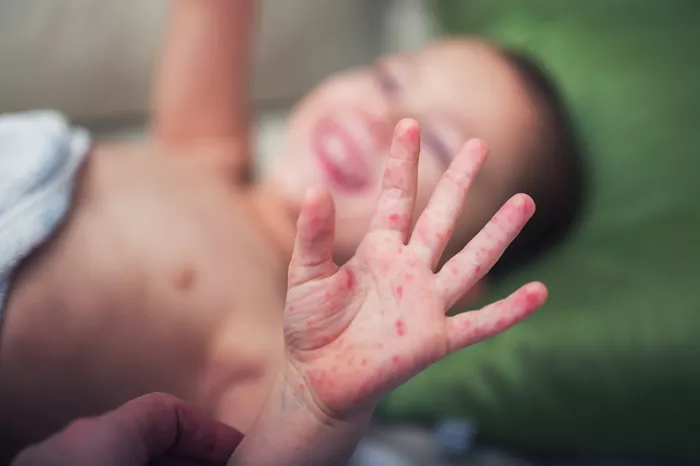Hand, foot, and mouth disease (HFMD) is a common viral illness primarily affecting young children, though it can also infect adults. The illness is characterized by fever, sores in the mouth, and a rash on the hands and feet. Understanding how long HFMD is contagious is essential for preventing its spread and managing the illness effectively.
Contagious Period of HFMD
HFMD is caused by viruses from the Enterovirus group, most commonly the coxsackievirus. The contagious period of HFMD typically begins a few days before symptoms appear and can continue for several weeks after symptoms have resolved. The virus is present in an infected person’s saliva, nasal secretions, fluid from blisters, and feces.
A person is most contagious during the first week of the illness. During this time, the virus spreads easily through close personal contact, respiratory droplets from coughs and sneezes, contact with feces, and touching contaminated surfaces. Even after symptoms disappear, the virus can still be present in the body, especially in the stool, for several weeks, making it possible to spread the virus to others.
Causes of Hand, Foot, and Mouth Disease
Hand, foot, and mouth disease (HFMD) is a common viral illness that primarily affects infants and children under the age of 10, though it can also affect adults. Understanding the causes of HFMD is essential for prevention and effective management.
Viral Agents Responsible for HFMD
HFMD is caused by viruses belonging to the Enterovirus genus, which includes several types of viruses. The most common causes of HFMD are:
Coxsackievirus A16: This is the most frequent cause of HFMD and usually leads to mild symptoms.
Enterovirus 71 (EV71): This virus can cause more severe cases of HFMD and is associated with serious complications such as viral meningitis, encephalitis, and poliomyelitis-like paralysis.
Other coxsackieviruses and enteroviruses can also cause HFMD, but they are less common.
Transmission of HFMD
HFMD spreads through various routes, including:
Direct Contact: Touching or close personal contact with an infected person can transmit the virus. This includes kissing, hugging, or sharing utensils and cups.
Respiratory Droplets: Coughing and sneezing release droplets that can carry the virus. Breathing in these droplets can lead to infection.
Contact with Contaminated Surfaces: The virus can survive on surfaces and objects. Touching these contaminated items and then touching the face can result in infection.
Fecal-Oral Route: Poor hand hygiene after using the bathroom or changing diapers can spread the virus. Infected individuals can shed the virus in their stool for weeks, even after they feel better.’
Symptoms and Course of HFMD
The symptoms of HFMD usually begin 3 to 6 days after exposure to the virus. The first sign is often a fever, followed by a sore throat and reduced appetite. A day or two after the fever starts, painful sores can develop in the mouth, including the tongue, gums, and inside of the cheeks. A skin rash with red spots and sometimes blisters can appear on the palms of the hands, soles of the feet, and occasionally on the buttocks and genital area.
The illness is typically mild and resolves on its own within 7 to 10 days. However, the duration and severity of symptoms can vary. Some people may experience only mild symptoms, while others, particularly young children, can have more severe symptoms that require medical attention.
See Also: Soothing Mouth Sores: Identification, Treatment & Prevention
Managing HFMD and Reducing Transmission
There is no specific treatment for HFMD. Symptom management focuses on relieving discomfort and preventing dehydration. Pain relievers such as acetaminophen or ibuprofen can reduce fever and ease pain from mouth sores. Drinking plenty of fluids is crucial to avoid dehydration, especially if mouth sores make swallowing painful.
To reduce the risk of spreading HFMD:
Practice Good Hygiene: Wash hands frequently with soap and water, especially after using the bathroom, changing diapers, and before eating.
Disinfect Surfaces: Clean and disinfect frequently touched surfaces and objects, such as toys, doorknobs, and countertops.
Avoid Close Contact: Keep infected individuals away from others, especially during the first week of illness. Avoid sharing utensils, cups, and towels.
Stay Home: Infected individuals, especially children, should stay home from school, daycare, and other group activities until they are no longer contagious.
Conclusion
Hand, foot, and mouth disease is highly contagious, especially during the first week of illness. The virus can still be present in the body for weeks after symptoms resolve, making it possible to spread the infection even after feeling better. Practicing good hygiene and taking preventive measures can help reduce the spread of HFMD. Understanding the contagious period and symptoms is essential for managing the illness and protecting others from infection.
FAQs
How long should a child with HFMD stay home from school or daycare?
A child with HFMD should stay home during the first week of illness when they are most contagious. They can return to school or daycare once they feel better, have no fever, and can participate in activities, but good hygiene practices should continue to prevent spreading the virus.
Can adults get hand, foot, and mouth disease?
Yes, adults can get HFMD, although it is more common in young children. Adults often have milder symptoms, but they can still spread the virus to others.
What should I do if my child has HFMD?
Ensure your child stays hydrated, manages pain with appropriate medication, and practices good hygiene. Keep your child home from school or daycare until they are no longer contagious. Contact your healthcare provider if symptoms are severe or if you have concerns.
Related topics:
- Understanding Heat Intolerance: Causes, Effects, and Management Strategies
- Topics to Talk About: What to Eat During Heat Exhaustion?
- How PTSD Affects Your Life?


